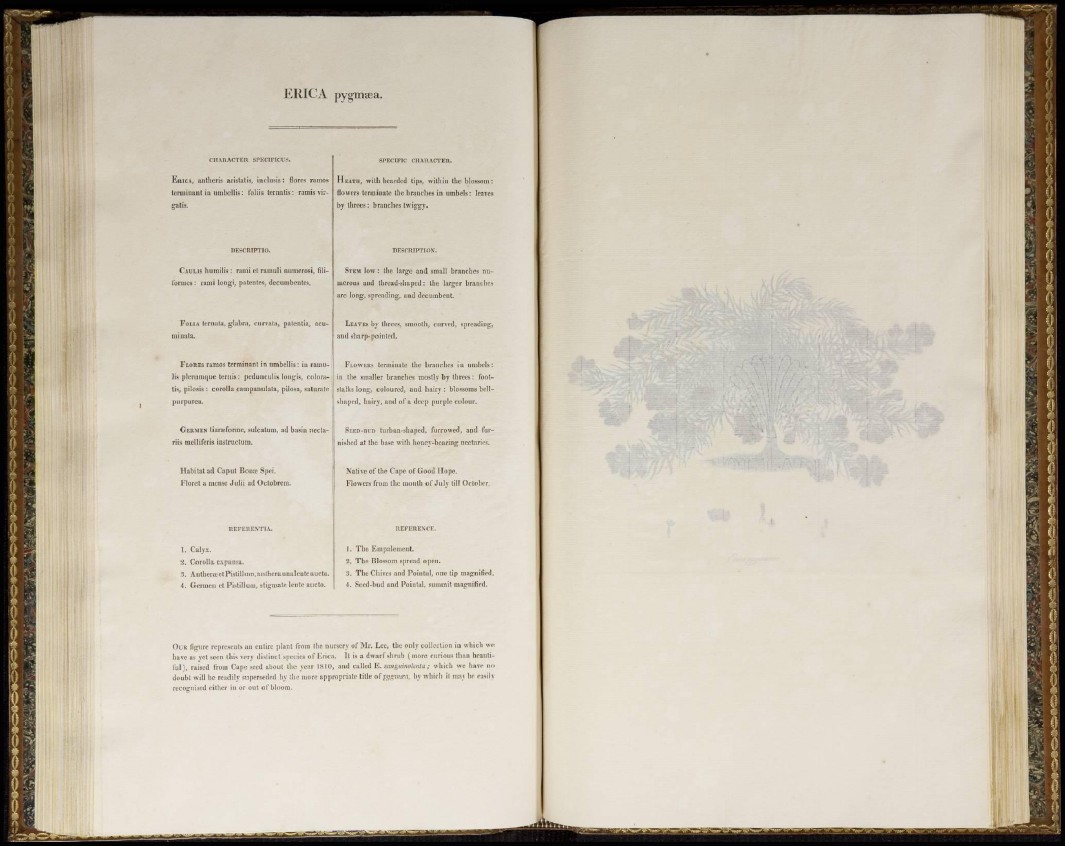
ERICA pygmaea.
CHARACTER SPECIFICUS.
ERICA, antheris aristatia, inclusis: flores ramos
terminant in umbcllis : foliis tcrnatis: ramis virgatis.
DESCRIPTIO.
CAUL is bumilis : rami ct ramuli numerosi, filiformes
: rami longi, patentes, decumbentes.
FOLIA ternata, glabra, curvata, patentia, acuminata.
F'LORES ramos terminant in umbellis: in r a m u -
lis plerumque ternis: pedunculis longis, coloratis,
pilosis : corolla eauipanulata, pilosa, saturate
purpurea.
GERMEN tiarasforme, sulcatum, ad basin nectariis
melliferis instructum.
H a b i t a t ad C a p u t B o n a ; Spei.
F l o r e t a mcnse J u l i i ad O c t o b r e m .
REFERENT! A.
1. C . l j » .
a. C o r o l l a e.vpausa.
3. A n t h e r a ; e t P i s t i l l u m , n n f h c r a t i n a I e n t e a u c t a.
4. G e r m e n et Pistillum, stigmate lente aucto.
SPECIFIC CHARACTER.
H EATII, w i t h bearded tips, w i t h i n the blossom:
flowers terminate the branches in umbels; leave*
by threes: branches t w i g g y .
DESCRIPTION.
STEM l o w : the large and small branches n u merous
and thread-shaped : the larger branches
are l o n g , spreading, and decumbent.
LEAVES by threes, smooth, curved, spreading,
and sharp-pointed.
FLOWERS terminate the branches in umbels:
in the smaller branches mostly b y threes: footstalks
l o n g , coloured, and hairy : blossoms bellshaped,
h a i r y , and o f a deep p u r p l e colour.
SEED-BCD turban-shaped, f u r r o w e d , and furnished
at the base w i t h honey-bearing nectaries.
N a t i v e o f the C a p e o f G o o d H o p e .
F l o w e r s from the mouth o f J u l y till O c t o b e r ,
REFF.RENCE-
1. T h e E m p a l e m e n t .
2. T h e Blossom spread open,
3. T h e ('hives and P o i n t a i , one t ip magnified.
4. Seed-hud and P o i n t a i , summit magnified.
OUR figure represents an entire plant f r om the nursery o f M r . L e e , the o n l y collection in w h i c h we
have as yet seen this very distinct species o f E r i c a . It is a d w a r f shrub (more curious than beautif
u l ) , raised from Cape seed about the year 1 8 1 0 , and called E . stmguinoknta; which we have n o
doubt will be readily superseded b y the more a p p r o p r i a t e title o f pygmara, by w h i c h it may be easily
recognised cither in o r o u t o f b l o o m .